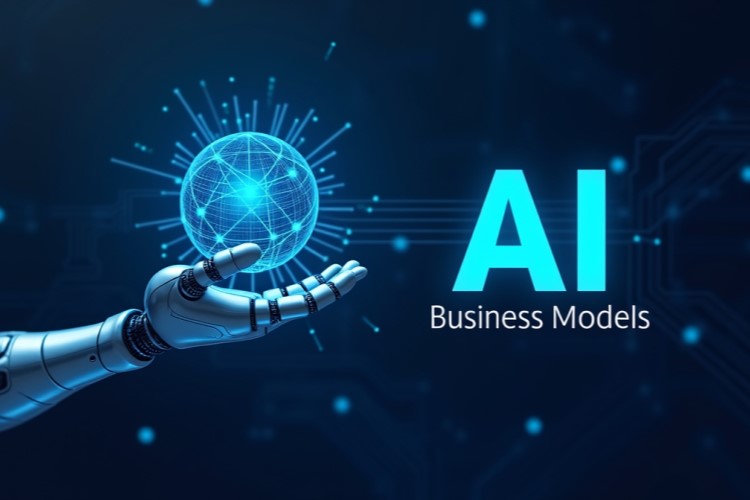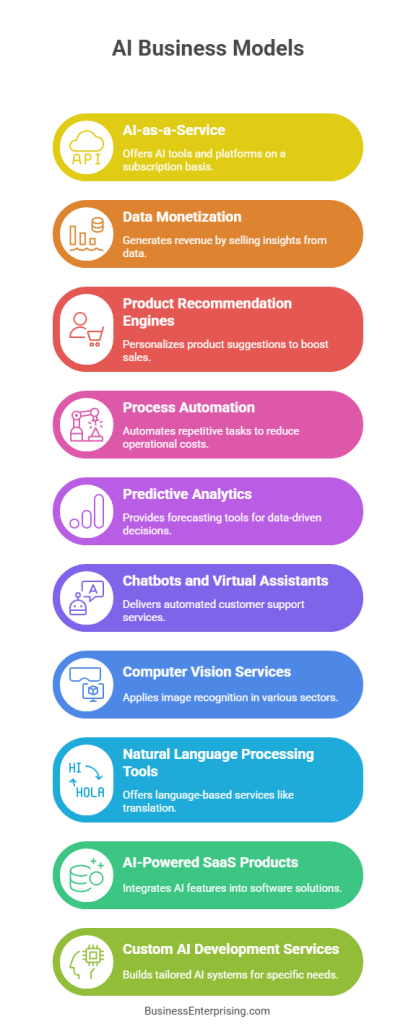
Additionally, AI can reduce costs, increase efficiency, and improve decision-making. Therefore, it offers benefits across many industries and business types. From retail and healthcare to finance and logistics, AI supports faster, more accurate operations. However, you’ll need more than just the tools. Success depends on how you apply them.
Your model must match your product, audience, and goals. That means thinking about how you price, support, and deliver your service. Additionally, you should consider your technical resources and long-term plans. Building a strong foundation now will help you scale more smoothly later.
However, it’s not just about growth. AI also brings new risks, costs, and ethical concerns. Therefore, you’ll need to balance speed with responsibility. Test your ideas early and stay open to adjustments. That way, you can learn what works before making bigger commitments.
As you plan your next steps, take time to study what others have done. Real examples offer helpful insight into what’s possible and what to avoid. AI is not a one-size-fits-all solution. But with the right approach, it can support lasting results.
Overview of AI-Driven Business Models
AI is no longer just a tool—it’s becoming part of the business model itself. Companies now use artificial intelligence to create value, automate processes, and improve decision-making. AI business models are built around this core idea. They use data, algorithms, and machine learning to deliver services, products, or insights more efficiently.
Additionally, these models often reduce reliance on manual labor. That means businesses can operate faster and with fewer errors. As a result, companies shift how they think about staffing, operations, and long-term growth. Traditional models may focus on assets or human capital, but AI models rely on data and automation.
Therefore, you may notice a different approach to product development. AI lets companies personalize services, predict behavior, and adjust offers in real time. That level of precision creates new revenue opportunities and helps retain customers. However, it also means rethinking how your business defines value.
AI business models aren’t limited to large tech firms. Small and mid-sized companies now use AI for customer service, analytics, and even marketing. Additionally, many firms offer AI as a service, allowing others to build custom solutions without starting from scratch.
If you’re considering this direction, look at how AI fits your existing goals. Think about where automation can cut costs or improve quality. Then decide if it makes sense to shift your business model around those changes.
AI is changing how companies work, sell, and grow. As the technology becomes more accessible, so does the opportunity to rethink what a business can do.
Types of AI Business Models
AI business models vary depending on how companies apply the technology. Each model serves a different purpose and offers unique value. One common model is AI-as-a-Service. This allows businesses to access AI tools through subscriptions or usage-based pricing. Therefore, you don’t need to build complex systems from scratch.
Additionally, many companies now monetize their data. If you collect useful information, you can package and sell insights to other businesses. However, data privacy laws must be considered before offering this type of service. Still, data monetization can become a steady revenue stream with the right audience.
Product recommendation engines are also popular. These systems use customer behavior to suggest relevant products in real time. This model increases sales without requiring more marketing spend. Additionally, it boosts customer satisfaction by helping people find what they want faster.
Process automation is another strong use of AI. You can automate tasks like invoicing, scheduling, and inventory tracking. This reduces labor costs and increases accuracy. Therefore, businesses can scale operations without adding more staff. AI-powered automation fits well into service, retail, and logistics industries.
Each model has its own technical and operational needs. However, they all focus on improving speed, precision, or efficiency. You’ll want to match the model to your business goals and resources. AI business models are flexible, so you can often combine more than one.
Additionally, start small and build from there. Once you find a working model, you can expand and refine your approach over time. The right fit depends on your data, your customers, and your ability to adapt.
Revenue Streams in AI-Powered Businesses
AI-powered businesses often build income around flexible and scalable revenue streams. These models focus on ongoing value rather than one-time sales. Therefore, many companies now prefer recurring payment structures.
Subscription pricing is one of the most common options. It offers predictable monthly or annual income while giving users steady access to services. Additionally, it allows you to scale based on the number of active users or features used. This model works well for software, platforms, and support services.
Licensing also provides strong revenue potential. You can charge businesses for the right to use your AI tools or algorithms. This is especially useful when selling to enterprise clients. However, licensing often involves longer sales cycles and more complex support agreements.
Usage-based pricing gives you another way to align value with customer activity. This model charges based on actual use, such as data processed or tasks completed. Therefore, it appeals to customers with varying needs or seasonal demand. It also supports growth as client usage increases.
Additionally, you can monetize data insights. If your system collects valuable information, you can package it for internal use or external sale. These insights help companies make better decisions, reduce risk, or predict trends. However, you must handle data carefully and follow privacy rules.
AI business models often combine more than one income stream. You might start with a subscription, then add usage tiers or insights later. The key is to stay flexible and align pricing with real value. That balance helps attract customers and support long-term growth.
AI Infrastructure and Technology Considerations
Building scalable AI systems requires the right infrastructure and tools. Without a strong foundation, your AI solution may not perform well. You’ll need cloud platforms, data storage, and processing power to support ongoing demand.
Additionally, cloud providers offer flexible resources that grow with your business. These services help you manage data, train models, and run algorithms at scale. Therefore, platforms like AWS, Google Cloud, and Azure are often part of AI operations.
However, infrastructure alone is not enough. You also need the right development tools. These include programming frameworks, machine learning libraries, and APIs. Choosing tools that match your team’s skills helps you build and deploy faster. It also reduces friction during updates or testing.
Data pipelines are another key part of the setup. You must collect, clean, and organize data for accurate results. Additionally, secure storage systems protect sensitive information while keeping it accessible. These steps directly affect model performance and user trust.
Partnerships also support long-term success. You may work with AI vendors, consulting firms, or data providers. These relationships fill gaps in expertise or resources. Therefore, don’t try to manage every part alone. Strong partners often help you scale faster and smarter.
AI business models depend on reliable systems and tools. The wrong setup can limit your product’s reach and effectiveness. However, a strong infrastructure supports growth, efficiency, and better customer outcomes. If you plan to scale, invest early in the right technology.
Challenges in Building AI Business Models
Building AI business models comes with real challenges. While the benefits are clear, the process takes time, money, and careful planning. One major issue is data privacy. You must collect and store user data responsibly. Failing to do so puts your brand at risk.
Additionally, data privacy rules vary by country and region. Therefore, you’ll need to understand which laws apply to your customers. Compliance is not optional and can affect your ability to scale. You’ll also need systems to manage user consent and handle sensitive information.
Ethical AI use is another growing concern. Your model must make fair, unbiased decisions. However, bias can enter through data, design, or training. Therefore, review your processes often and test for unintended patterns. Clear documentation also helps explain how your system works.
Development and maintenance costs can be high. AI tools require advanced skills and continuous updates. Additionally, system training uses large amounts of computing power. These costs often grow with your user base. Therefore, budgeting for long-term support is important from the start.
Regulatory rules continue to evolve. You may face new requirements as AI laws take shape. This creates added pressure to stay informed and flexible. However, keeping up with changes can protect your business from legal risks.
AI business models rely on trust, transparency, and ongoing investment. If you plan ahead and monitor key risks, you’ll be better prepared. That helps you build a stronger product and a more stable business over time.
Case Studies and Industry Examples
Many companies now use AI to improve their business performance. These real-world examples show how different industries apply AI successfully. Healthcare, retail, and finance each use AI in unique and practical ways.
In healthcare, some providers use AI to speed up diagnoses. Systems review scans and medical records to detect issues early. Additionally, virtual assistants help manage patient scheduling and follow-up. These tools reduce workloads and improve service accuracy.
Retail companies also apply AI to personalize shopping experiences. Some brands use algorithms to suggest products based on past behavior. This improves conversion rates and customer satisfaction. Additionally, inventory systems powered by AI help stores reduce waste and avoid stockouts.
Financial firms often use AI to detect fraud. These tools scan transactions for suspicious patterns in real time. Therefore, banks can act quickly and reduce losses. AI also helps with loan approvals by assessing risk more accurately and faster than traditional systems.
However, success depends on choosing the right use case. You need to match the tool to the problem you want to solve. Additionally, good data and regular updates keep the systems working well over time.
AI business models support a range of strategies across sectors. Each company adapts the technology to fit its goals and resources. If you’re exploring AI for your business, these examples show what’s possible. Learn from others, but build around your own needs.
Conclusion
AI continues to shape how companies create, deliver, and capture value. As more businesses adopt it, the need for smart planning grows. AI business models offer new ways to serve customers and operate more efficiently.
However, success depends on more than just the technology. You need clear goals, reliable data, and the right systems to support growth. Therefore, build a strong foundation before you scale. Each part of your model should serve a purpose and support your long-term goals.
Additionally, keep your users in mind. Whether you sell software, services, or insights, your solution must solve a real problem. AI works best when it adds measurable value. Therefore, test and adjust based on user feedback and performance data.
Costs and risks will always be part of the process. However, you can reduce them with strong partnerships and smart decisions. If you manage these areas well, you’ll be better positioned for sustainable results.
AI changes fast, so stay flexible. Your model today might need updates tomorrow. Additionally, new rules or technologies may shape your strategy. Keep learning and adjusting as the field grows.
If you focus on value, clarity, and efficiency, your AI model will support your business for the long term. Make it work for your needs—not just for the trend.



